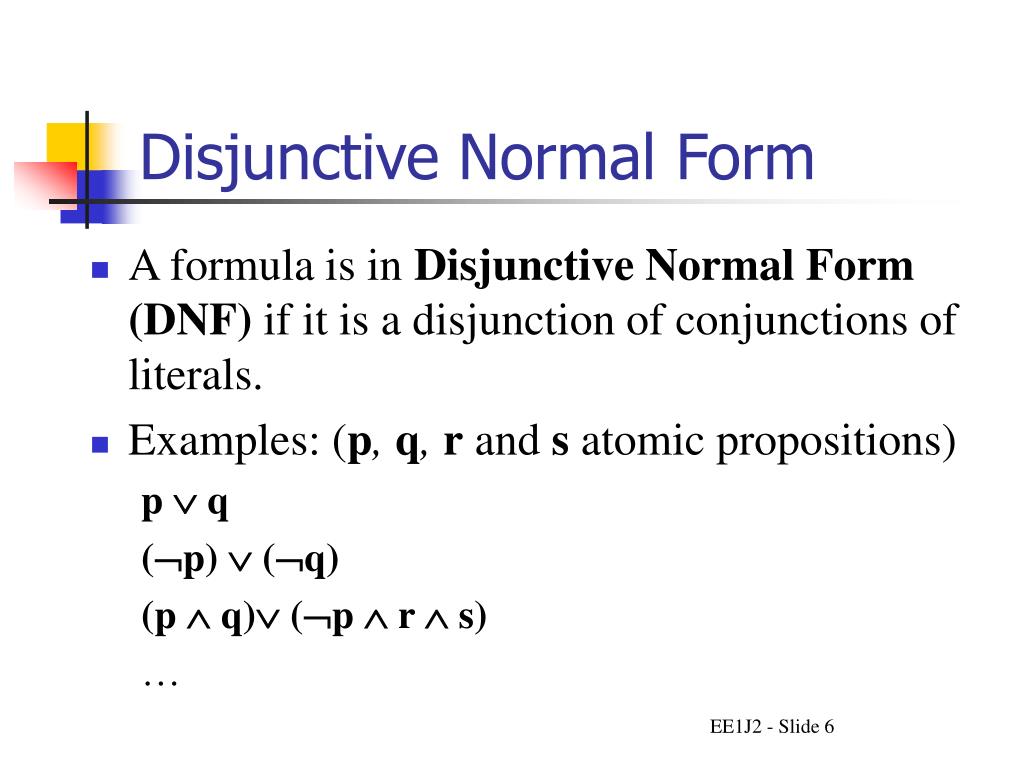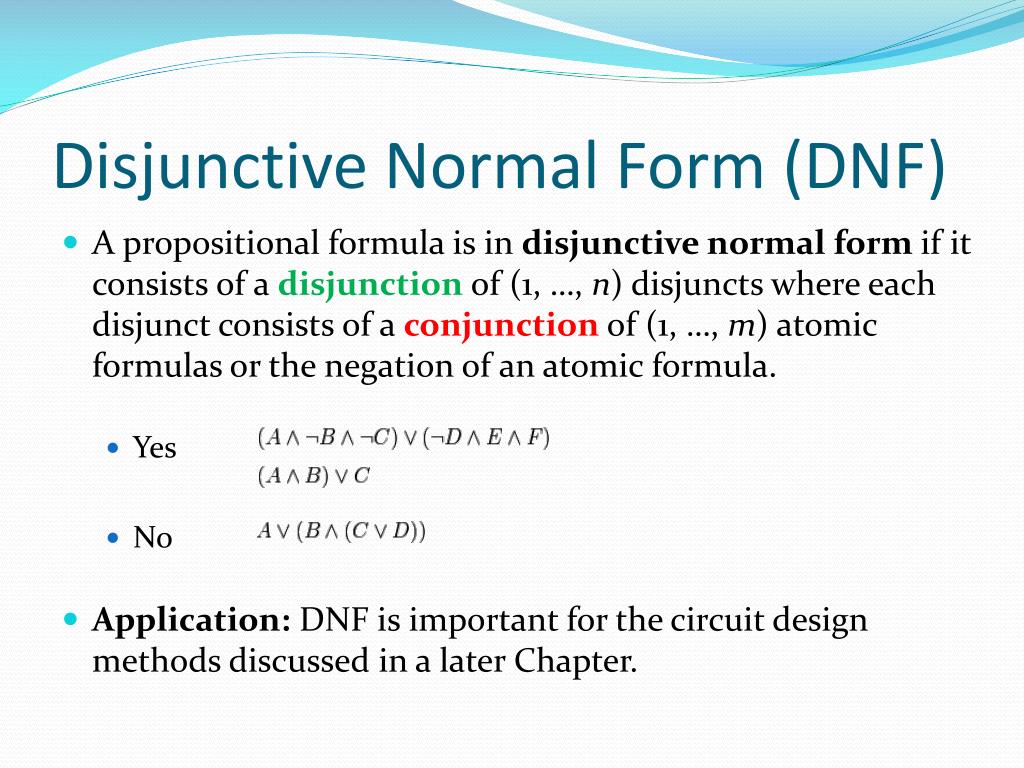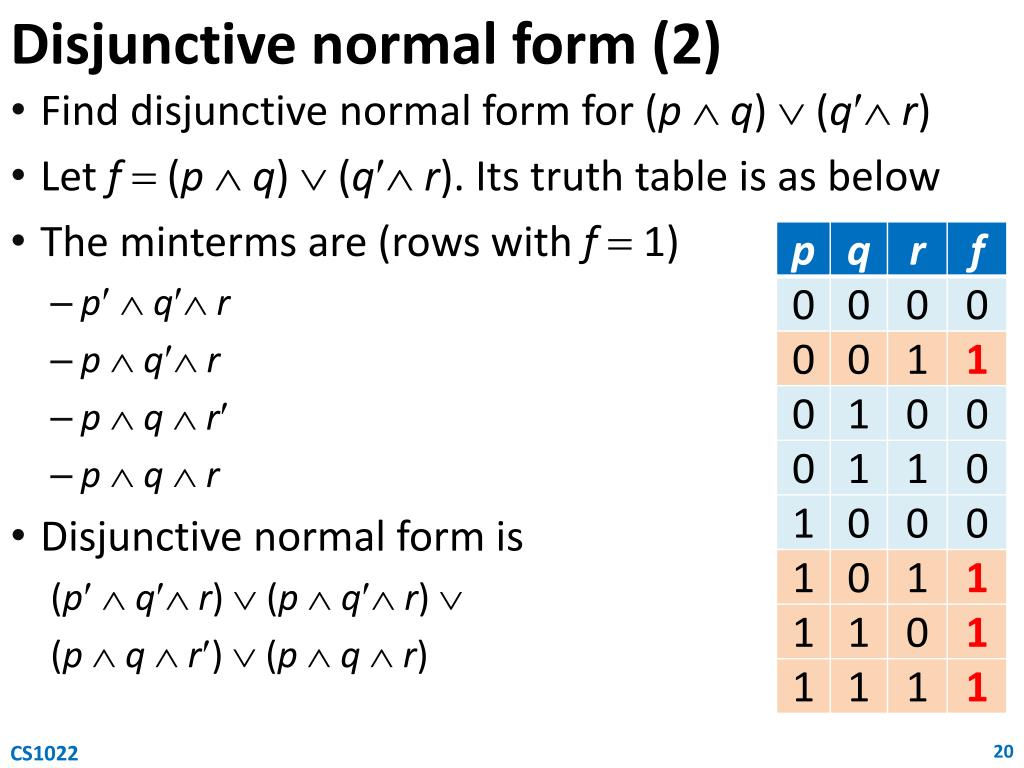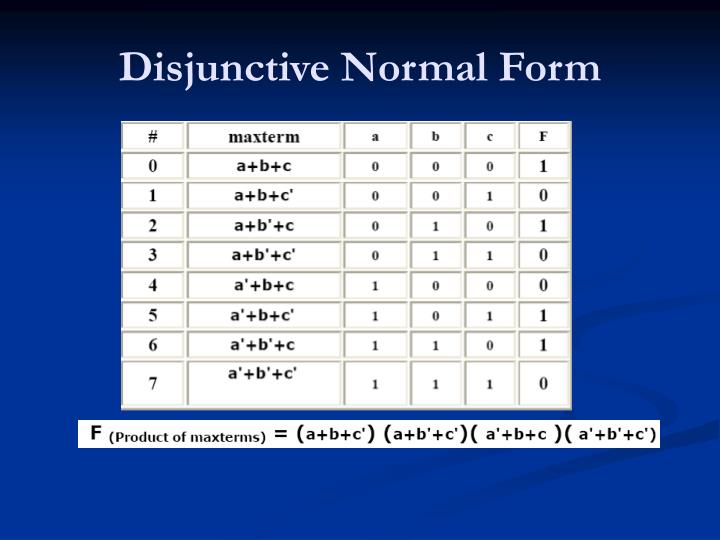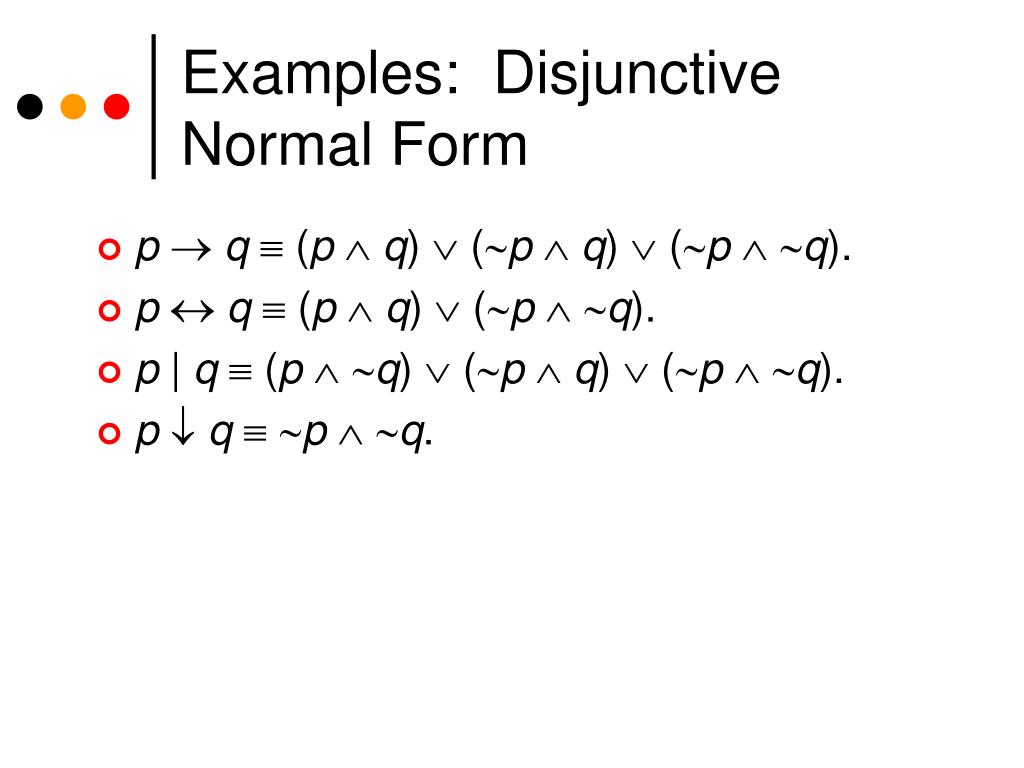Disjunctive Normal Form
Disjunctive Normal Form - In other words, a logical formula is said to be in disjunctive normal form if it is a disjunction of conjunctions with every variable and its negation is present once in each conjunction. Disjunctive normal form is not unique. For a given set of $m$ propositional variables $p_1,\ldots,p_m$, the normal form is that in which each term $\wedge c_ {ij}$ contains exactly $m$ terms $c_ {ij}$, each being either $p_j$ or $\neg p_j$, and in which no term is repeated. Disjunctive normal form a boolean polynomial in variables x1, x2,., xn which is the disjunction of distinct terms of the form a1 ∧ a2 ∧ ⋯ ∧ an, where each ai is either xi or x ′ i. To understand dnf, first the concept of a minterm will be covered. Convention 3.2.1 the zero polynomial is also considered to be in disjunctive normal form. P and not q p && (q || r) truth tables compute a truth table for a boolean. This form is then unique up to order. Web disjunctive normal form (dnf) is the normalization of a logical formula in boolean mathematics. Three literals of the form {}:
Web disjunctive normal form (dnf) is the normalization of a logical formula in boolean mathematics. This form is then unique up to order. P and not q p && (q || r) truth tables compute a truth table for a boolean. For a given set of $m$ propositional variables $p_1,\ldots,p_m$, the normal form is that in which each term $\wedge c_ {ij}$ contains exactly $m$ terms $c_ {ij}$, each being either $p_j$ or $\neg p_j$, and in which no term is repeated. Web in boolean logic, a disjunctive normal form (dnf) is a canonical normal form of a logical formula consisting of a disjunction of conjunctions; In other words, a logical formula is said to be in disjunctive normal form if it is a disjunction of conjunctions with every variable and its negation is present once in each conjunction. Hence the normal form here is actually (p q). Web a statement is in disjunctive normal form if it is a disjunction (sequence of ors) consisting of one or more disjuncts, each of which is a conjunction of one or more literals (i.e., statement letters and negations of statement letters; A2 and one disjunction containing { f, p, t }: It can also be described as an or of ands, a sum of products, or (in philosophical logic) a cluster concept.
Three literals of the form {}: A2 and one disjunction containing { f, p, t }: It can also be described as an or of ands, a sum of products, or (in philosophical logic) a cluster concept. Web disjunctive normal form (dnf) is a standard way to write boolean functions. Disjunctive normal form a boolean polynomial in variables x1, x2,., xn which is the disjunction of distinct terms of the form a1 ∧ a2 ∧ ⋯ ∧ an, where each ai is either xi or x ′ i. A minterm is a row in the truth table where the output function for that term is true. Web a statement is in disjunctive normal form if it is a disjunction (sequence of ors) consisting of one or more disjuncts, each of which is a conjunction of one or more literals (i.e., statement letters and negations of statement letters; Disjunctive normal form is not unique. Web the form \ref {eq1} may be referred to as a disjunctive form: The rules have already been simplified a bit:
Disjunctive Normal Form DISCRETE MATHEMATICS( problem solve) YouTube
Hence the normal form here is actually (p q). Three literals of the form {}: Web disjunctive normal form natural language math input extended keyboard examples assuming disjunctive normal form is a general topic | use as referring to a mathematical definition instead examples for boolean algebra boolean algebra analyze a boolean expression: Convention 3.2.1 the zero polynomial is also.
Aislamy Conjunctive Normal Form Examples Ppt
Web the form \ref {eq1} may be referred to as a disjunctive form: Convention 3.2.1 the zero polynomial is also considered to be in disjunctive normal form. Disjunctive normal form a boolean polynomial in variables x1, x2,., xn which is the disjunction of distinct terms of the form a1 ∧ a2 ∧ ⋯ ∧ an, where each ai is either.
PPT EE1J2 Discrete Maths Lecture 6 PowerPoint Presentation, free
Web in boolean logic, a disjunctive normal form (dnf) is a canonical normal form of a logical formula consisting of a disjunction of conjunctions; For a given set of $m$ propositional variables $p_1,\ldots,p_m$, the normal form is that in which each term $\wedge c_ {ij}$ contains exactly $m$ terms $c_ {ij}$, each being either $p_j$ or $\neg p_j$, and in.
Express into Disjunctive Normal Form (DNF) YouTube
A2 and one disjunction containing { f, p, t }: A minterm is a row in the truth table where the output function for that term is true. Web a statement is in disjunctive normal form if it is a disjunction (sequence of ors) consisting of one or more disjuncts, each of which is a conjunction of one or more.
PPT Discrete Mathematics Applications of PL and Propositional
The rules have already been simplified a bit: Web disjunctive normal form natural language math input extended keyboard examples assuming disjunctive normal form is a general topic | use as referring to a mathematical definition instead examples for boolean algebra boolean algebra analyze a boolean expression: Web a statement is in disjunctive normal form if it is a disjunction (sequence.
PPT CS1022 Computer Programming & Principles PowerPoint Presentation
To understand dnf, first the concept of a minterm will be covered. For a given set of $m$ propositional variables $p_1,\ldots,p_m$, the normal form is that in which each term $\wedge c_ {ij}$ contains exactly $m$ terms $c_ {ij}$, each being either $p_j$ or $\neg p_j$, and in which no term is repeated. Web a statement is in disjunctive normal.
Solved Consider The Following Logic Table Find The Disju...
This form is then unique up to order. For a given set of $m$ propositional variables $p_1,\ldots,p_m$, the normal form is that in which each term $\wedge c_ {ij}$ contains exactly $m$ terms $c_ {ij}$, each being either $p_j$ or $\neg p_j$, and in which no term is repeated. Web a statement is in disjunctive normal form if it is.
PPT Chapter 4 PowerPoint Presentation ID1354350
A2 and one disjunction containing { f, p, t }: Three literals of the form {}: For each of the following logical statements, find the truth value and from that information find the logically equivalent disjunctive normal form. It can also be described as an or of ands, a sum of products, or (in philosophical logic) a cluster concept. For.
PPT Application Digital Logic Circuits PowerPoint Presentation, free
Three literals of the form {}: In other words, a logical formula is said to be in disjunctive normal form if it is a disjunction of conjunctions with every variable and its negation is present once in each conjunction. Web disjunctive normal form (dnf) is the normalization of a logical formula in boolean mathematics. P and not q p &&.
Disjunctive normal form.pdf Theoretical Computer Science Metalogic
A2 and one disjunction containing { f, p, t }: It can also be described as an or of ands, a sum of products, or (in philosophical logic) a cluster concept. A minterm is a row in the truth table where the output function for that term is true. To understand dnf, first the concept of a minterm will be.
For A Given Set Of $M$ Propositional Variables $P_1,\Ldots,P_M$, The Normal Form Is That In Which Each Term $\Wedge C_ {Ij}$ Contains Exactly $M$ Terms $C_ {Ij}$, Each Being Either $P_J$ Or $\Neg P_J$, And In Which No Term Is Repeated.
Since there are no other normal forms, this will also be considered the disjunctive normal form. Three literals of the form {}: A2 and one disjunction containing { f, p, t }: Web disjunctive normal form (dnf) is the normalization of a logical formula in boolean mathematics.
For Each Of The Following Logical Statements, Find The Truth Value And From That Information Find The Logically Equivalent Disjunctive Normal Form.
P and not q p && (q || r) truth tables compute a truth table for a boolean. This form is then unique up to order. Disjunctive normal form a boolean polynomial in variables x1, x2,., xn which is the disjunction of distinct terms of the form a1 ∧ a2 ∧ ⋯ ∧ an, where each ai is either xi or x ′ i. A minterm is a row in the truth table where the output function for that term is true.
Disjunctive Normal Form Is Not Unique.
Web a statement is in disjunctive normal form if it is a disjunction (sequence of ors) consisting of one or more disjuncts, each of which is a conjunction of one or more literals (i.e., statement letters and negations of statement letters; It can also be described as an or of ands, a sum of products, or (in philosophical logic) a cluster concept. Web in boolean logic, a disjunctive normal form (dnf) is a canonical normal form of a logical formula consisting of a disjunction of conjunctions; The rules have already been simplified a bit:
Web Disjunctive Normal Form (Dnf) Is A Standard Way To Write Boolean Functions.
It can be described as a sum of products, and an or and ands 3. To understand dnf, first the concept of a minterm will be covered. In other words, a logical formula is said to be in disjunctive normal form if it is a disjunction of conjunctions with every variable and its negation is present once in each conjunction. Hence the normal form here is actually (p q).


